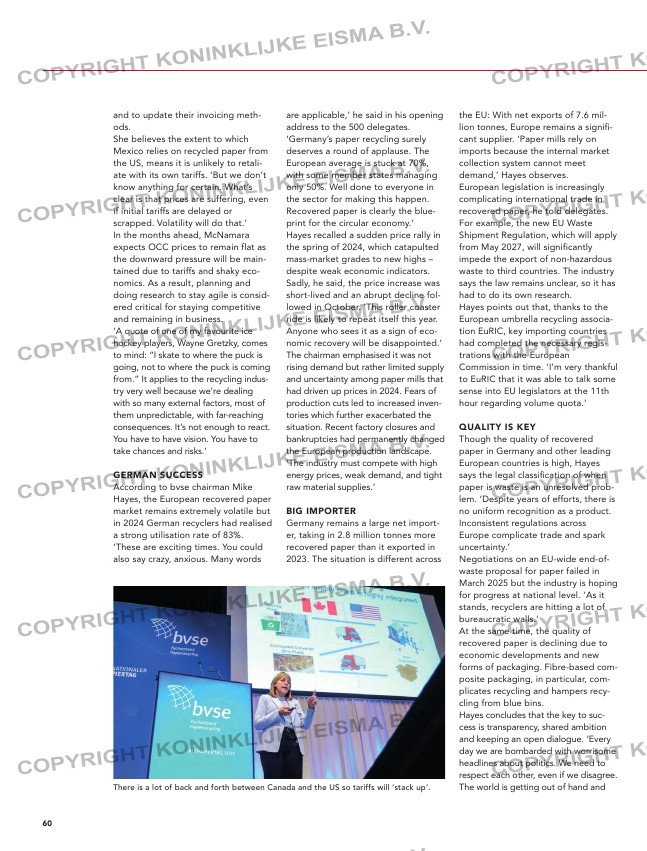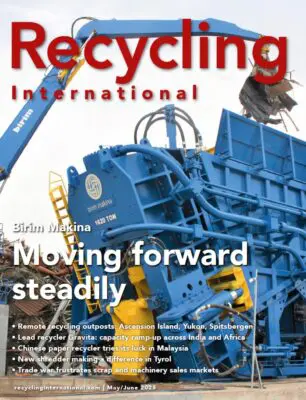Page 60 from: Recycling International May/June issue

60
and to update their invoicing meth-
ods.
She believes the extent to which
Mexico relies on recycled paper from
the US, means it is unlikely to retali-
ate with its own tariffs. ‘But we don’t
know anything for certain. What’s
clear is that prices are suffering, even
if initial tariffs are delayed or
scrapped. Volatility will do that.’
In the months ahead, McNamara
expects OCC prices to remain flat as
the downward pressure will be main-
tained due to tariffs and shaky eco-
nomics. As a result, planning and
doing research to stay agile is consid-
ered critical for staying competitive
and remaining in business.
‘A quote of one of my favourite ice
hockey players, Wayne Gretzky, comes
to mind: “I skate to where the puck is
going, not to where the puck is coming
from.” It applies to the recycling indus-
try very well because we’re dealing
with so many external factors, most of
them unpredictable, with far-reaching
consequences. It’s not enough to react.
You have to have vision. You have to
take chances and risks.’
GERMAN SUCCESS
According to bvse chairman Mike
Hayes, the European recovered paper
market remains extremely volatile but
in 2024 German recyclers had realised
a strong utilisation rate of 83%.
‘These are exciting times. You could
also say crazy, anxious. Many words
are applicable,’ he said in his opening
address to the 500 delegates.
‘Germany’s paper recycling surely
deserves a round of applause. The
European average is stuck at 70%,
with some member states managing
only 50%. Well done to everyone in
the sector for making this happen.
Recovered paper is clearly the blue-
print for the circular economy.’
Hayes recalled a sudden price rally in
the spring of 2024, which catapulted
mass-market grades to new highs –
despite weak economic indicators.
Sadly, he said, the price increase was
short-lived and an abrupt decline fol-
lowed in October. ‘This roller coaster
ride is likely to repeat itself this year.
Anyone who sees it as a sign of eco-
nomic recovery will be disappointed.’
The chairman emphasised it was not
rising demand but rather limited supply
and uncertainty among paper mills that
had driven up prices in 2024. Fears of
production cuts led to increased inven-
tories which further exacerbated the
situation. Recent factory closures and
bankruptcies had permanently changed
the European production landscape.
‘The industry must compete with high
energy prices, weak demand, and tight
raw material supplies.’
BIG IMPORTER
Germany remains a large net import-
er, taking in 2.8 million tonnes more
recovered paper than it exported in
2023. The situation is different across
the EU: With net exports of 7.6 mil-
lion tonnes, Europe remains a signifi-
cant supplier. ‘Paper mills rely on
imports because the internal market
collection system cannot meet
demand,’ Hayes observes.
European legislation is increasingly
complicating international trade in
recovered paper, he told delegates.
For example, the new EU Waste
Shipment Regulation, which will apply
from May 2027, will significantly
impede the export of non-hazardous
waste to third countries. The industry
says the law remains unclear, so it has
had to do its own research.
Hayes points out that, thanks to the
European umbrella recycling associa-
tion EuRIC, key importing countries
had completed the necessary regis-
trations with the European
Commission in time. ‘I’m very thankful
to EuRIC that it was able to talk some
sense into EU legislators at the 11th
hour regarding volume quota.’
QUALITY IS KEY
Though the quality of recovered
paper in Germany and other leading
European countries is high, Hayes
says the legal classification of when
paper is waste is an unresolved prob-
lem. ‘Despite years of efforts, there is
no uniform recognition as a product.
Inconsistent regulations across
Europe complicate trade and spark
uncertainty.’
Negotiations on an EU-wide end-of-
waste proposal for paper failed in
March 2025 but the industry is hoping
for progress at national level. ‘As it
stands, recyclers are hitting a lot of
bureaucratic walls.’
At the same time, the quality of
recovered paper is declining due to
economic developments and new
forms of packaging. Fibre-based com-
posite packaging, in particular, com-
plicates recycling and hampers recy-
cling from blue bins.
Hayes concludes that the key to suc-
cess is transparency, shared ambition
and keeping an open dialogue. ‘Every
day we are bombarded with worrisome
headlines about politics. We need to
respect each other, even if we disagree.
The world is getting out of hand and There is a lot of back and forth between Canada and the US so tariffs will ‘stack up’.
it’s easy to get caught up in that nega-
tive energy. It’s a shame and it distracts
us from what really matters.’
NORTH AMERICAN MARKET
During her presentation, McNamara
also reviewed the North American
recovered paper market over the last
15 years, pointing out that demand
for containerboard has been consis-
tent (up 1.2% since 2009) while
graphic paper demand has been in
decline (down 7%).
Of the main grades globally, demand
for high grades has been decreasing
more slowly in North America over
the last decade. In 2014, demand was
12.4 million tonnes, while it was just
7.0 million tonnes last year, an annual
dip in supply of 5.3%. But both in
North America and the export mar-
ket, high grade demand from mills
has dropped only 1.3% over the
same period. ‘This is why we’re see-
ing tissue mills move more towards
virgin fibre to make up for the short-
fall in supply,’ McNamara adds.
Better collecting and sorting of old
newspaper grade (ONP) is becoming
more important as supply falls.
Demand for the grade, mostly used in
building materials and cardboard
packaging, has been dropping rapidly
for over ten years. Today, ONP makes
up less than 40% of total recovered
fibre in the US and Canada.
MIXED AND OCC
Mixed paper, which has always been a
‘catch-all category’ has seen ‘pretty
flat’ domestic demand, with almost
no change since 2014. However,
export demand has fallen rapidly,
sparked by China’s National Sword
campaign, followed by other Asian
players unhappy they were ‘importing
garbage’. With domestic demand sta-
ble, the grade has witnessed an over-
all fall of around 4.5% per year.
The most popular grade remains
OCC, which makes up around 70%
paper recycling market. Demand is up
5.8% in 2024 after two weak years.
‘Finally a rebound,’ exclaims
McNamara. ‘Mostly driven by new
capacity (roughly 3.7 million tonnes)
that came online in North America in
58-59-60-61_altpapiertag.indd 60 10-04-2025 14:22



